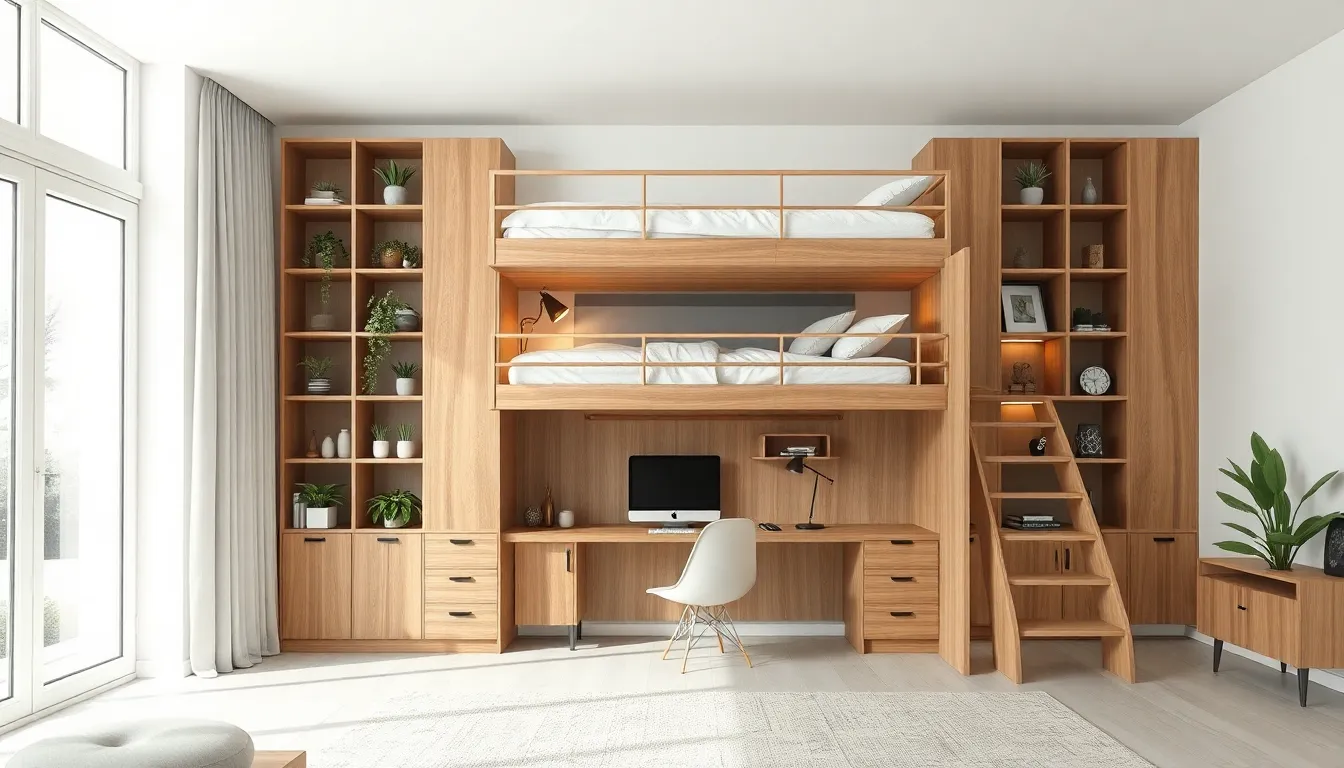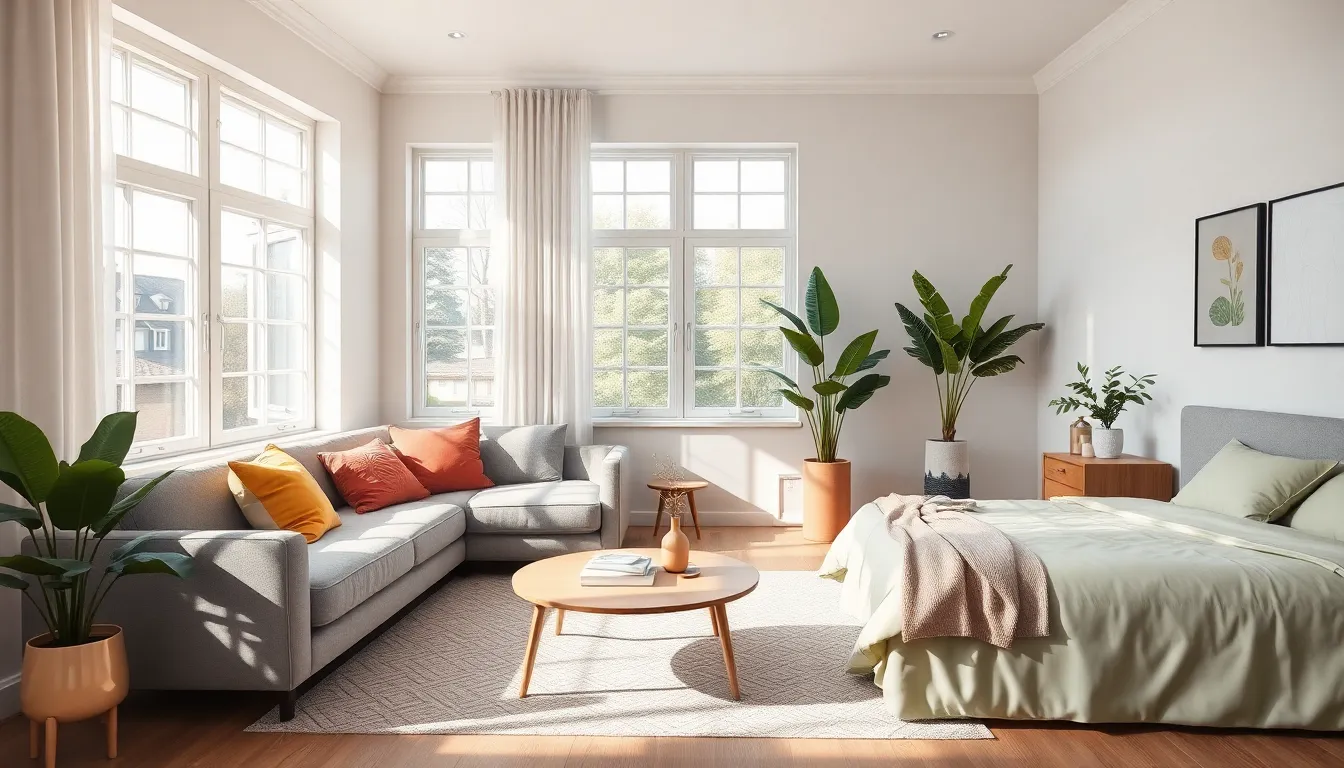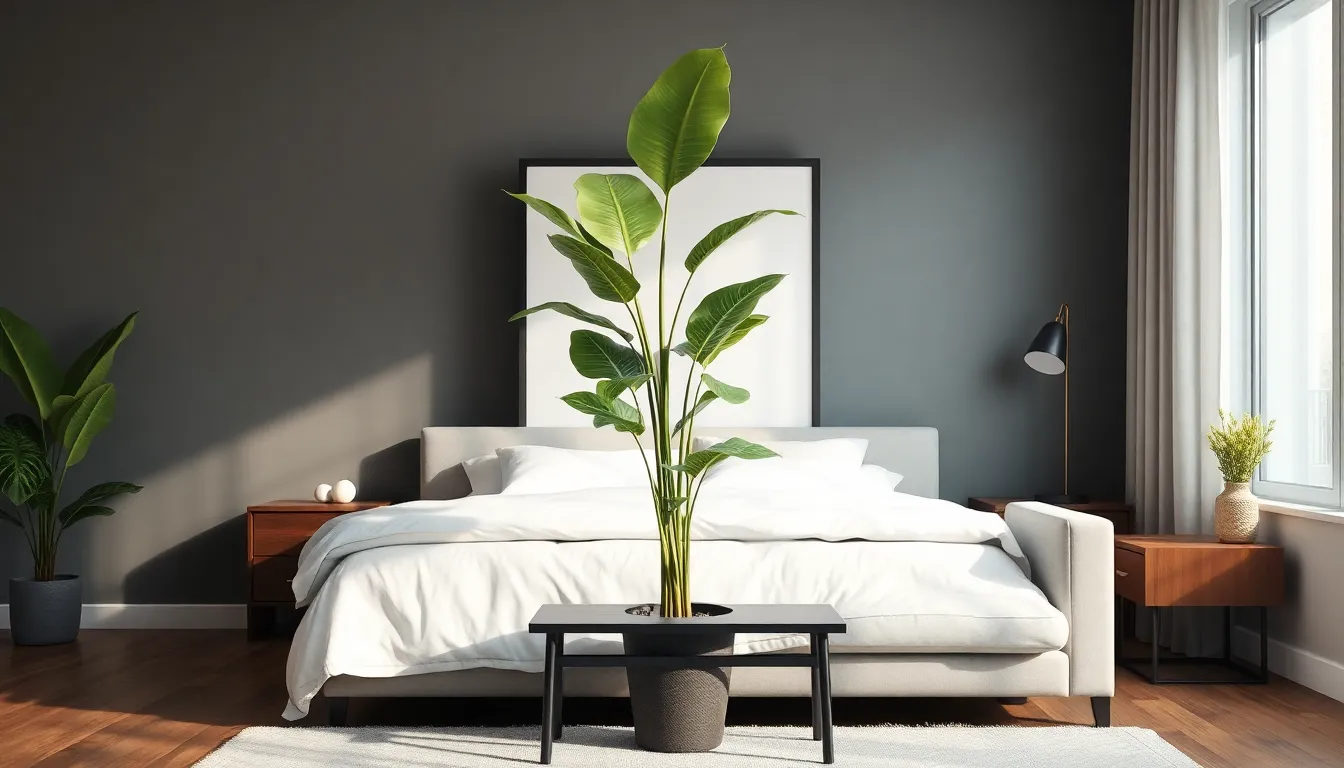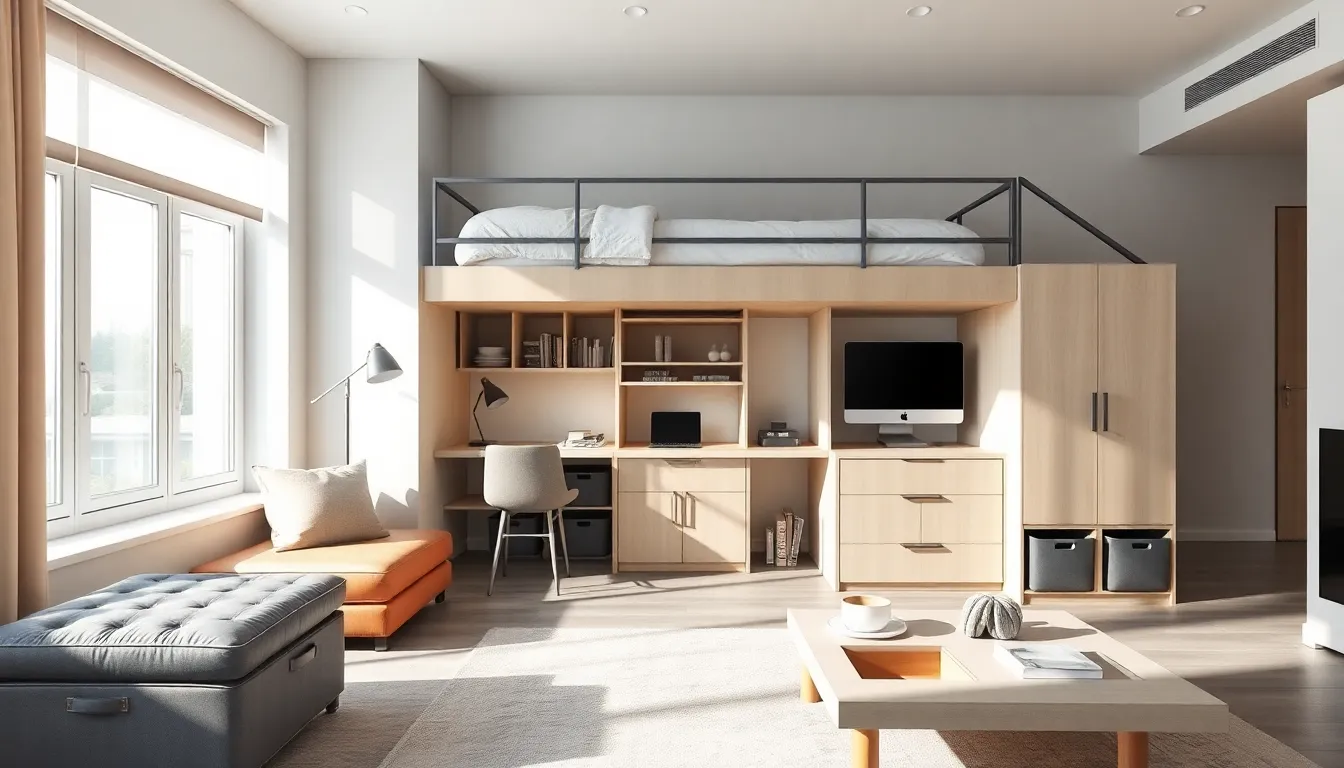We’ve all been there – staring at a small space wondering how we’ll fit both a living area and bedroom into one room. Whether you’re dealing with a studio apartment, dorm room, or simply want to maximize your home’s functionality, living room bedroom combos offer the perfect solution for modern living.
The key to creating a successful dual-purpose space lies in smart design choices that don’t compromise comfort or style. We’re talking about clever furniture arrangements, strategic room dividers, and multi-functional pieces that work overtime to give you the best of both worlds.
With the right approach, your combo room can feel spacious, organized, and surprisingly luxurious. From Murphy beds that disappear during the day to stylish screens that create instant privacy, we’ll show you how to transform your challenging space into a functional haven that serves all your needs without very costly.
Creating Distinct Zones With Room Dividers
Room dividers transform your living room bedroom combo by establishing clear boundaries between spaces without permanent construction. We’ll explore three effective approaches that maintain openness while creating functional separation.
Using Curtains and Drapes
Curtains offer the most budget-friendly solution for dividing your combo space. We recommend installing a ceiling-mounted track system that extends from wall to wall, allowing you to pull curtains completely open during the day. Heavy fabrics like velvet or thick cotton provide excellent sound dampening and visual privacy when you need to sleep.
Floor-to-ceiling panels create dramatic height in your room while maintaining flexibility. We suggest choosing colors that complement both your living and sleeping areas, such as neutral tones or subtle patterns. Blackout curtains work particularly well for bedroom zones, blocking light from living area activities.
Double-layer curtain systems give you maximum control over privacy and light. We often pair sheer panels with heavier drapes, letting you adjust transparency throughout the day. This approach costs significantly less than permanent room dividers while offering similar functionality.
Installing Sliding Panels
Sliding panels provide a modern, streamlined approach to space division in combo rooms. We recommend track-mounted systems that glide smoothly and stack neatly when not in use. Japanese-style shoji screens or contemporary frosted glass panels work exceptionally well for this purpose.
Hardware installation requires basic tools and typically takes one weekend to complete. We suggest measuring your ceiling height carefully and choosing panels that reach within 2-3 inches of the floor. This creates visual separation while allowing air circulation throughout your space.
Material options range from lightweight fabric panels to solid wood or acrylic sheets. We find that translucent materials maintain a sense of openness while still defining separate zones. Many sliding panel systems cost between $200-600 depending on size and materials chosen.
Building Custom Shelving Units
Custom shelving units serve dual purposes as room dividers and storage answers for combo spaces. We recommend open-back designs that allow light to filter through while creating distinct zones. Floating shelves or modular cube systems work particularly well for this application.
Height variations add visual interest while maintaining functionality throughout your space. We suggest alternating shelf heights and incorporating both open storage and closed cabinets. This approach lets you display decorative items on the living room side while hiding bedroom essentials.
DIY shelving projects typically cost $150-400 in materials and can be completed over a weekend. We recommend using wall anchors rated for the weight of your shelving system, especially for floor-to-ceiling installations. Many homeowners choose to add wheels to lower shelving units for occasional repositioning.
Maximizing Vertical Space for Storage

When you’re working with limited square footage, we believe vertical space becomes your most valuable asset for storage answers. Building upward instead of outward helps maintain the open feel we discussed with room dividers while dramatically increasing your storage capacity.
Wall-Mounted Shelving Answers
Floating shelves create visual lightness while providing essential storage without consuming floor space. We recommend installing these shelves at varying heights to store books, decorative items, and daily essentials while maintaining an uncluttered appearance.
Bracket systems offer maximum flexibility for adjusting shelf heights as your storage needs change. These modular answers allow you to customize spacing between shelves to accommodate different sized items like linens or personal care products.
Corner shelving units use often overlooked spaces where walls meet, transforming dead zones into functional storage areas. We find these particularly effective for displaying plants or storing items you don’t need daily access to.
Loft Bed Designs
Elevated sleeping areas free up valuable floor space underneath for multiple purposes beyond traditional bedroom storage. We’ve seen clients transform the area below into productive workspaces, cozy reading nooks, or additional storage zones.
Built in desks underneath loft beds create dedicated workspace areas that don’t compete with your living room layout. This setup works particularly well for students or remote workers who need a defined office space.
Storage drawers integrated into loft bed frames maximize every inch of available space while keeping belongings organized and easily accessible. We suggest choosing designs with smooth gliding mechanisms for daily convenience.
Floor-to-Ceiling Storage Units
Tall cabinets that stretch from floor to ceiling create impressive storage capacity while drawing the eye upward to make rooms appear larger. We recommend choosing units with a mix of open shelving and closed storage to balance display and concealment needs.
Sliding doors on vertical storage units save precious floor space that traditional hinged doors would require. These space saving mechanisms improve accessibility while maintaining the clean lines essential in combo room designs.
Custom built storage walls can incorporate everything from clothing storage to entertainment centers while serving as effective room dividers. We find these answers particularly effective when designed with neutral color palettes and strategic pops of color to maintain visual appeal.
Choosing Multi-Functional Furniture Pieces

Smart furniture selections become essential when we’re combining living and sleeping areas in one space. Multi-functional pieces serve double duty while maintaining style and comfort throughout our combo room.
Convertible Sofa Beds
Convertible sofa beds transform our living space from day to night with seamless functionality. These versatile pieces serve as comfortable seating during daytime hours and convert into full sleeping accommodations when needed. Modern designs feature memory foam mattresses and sturdy frames that rival traditional beds in comfort quality.
Quality sofa beds come in various styles including sectionals, loveseats, and full-size sofas to match our space requirements. Pull-out mechanisms range from simple fold-down designs to sophisticated click-clack systems that operate smoothly. Storage compartments built into many models provide additional space for bedding, pillows, and personal items.
Ottoman Storage Benches
Ottoman storage benches maximize our floor space while providing essential seating and organization answers. These dual-purpose pieces offer hidden storage compartments perfect for storing blankets, books, electronics, and seasonal items. Upholstered tops create comfortable extra seating for guests or serve as footrests during relaxation time.
Rectangular ottomans work well as coffee table alternatives while round versions complement curved furniture arrangements. Leather and fabric options coordinate with existing decor themes from contemporary to traditional styles. Weight capacity varies by model with many supporting up to 300 pounds for reliable everyday use.
Expandable Coffee Tables
Expandable coffee tables adapt to our changing needs throughout the day and accommodate various activities. These innovative pieces extend their surface area when we’re entertaining guests or working on projects, then contract to save space during regular use. Lift-top designs reveal hidden storage compartments while raising the surface to comfortable working height.
Butterfly leaf extensions and slide-out panels double the table surface area in seconds. Height-adjustable models serve as both coffee tables and dining surfaces for casual meals. Materials range from solid wood to engineered composites with finishes that complement our existing furniture pieces perfectly.
Implementing Smart Lighting Strategies

Proper lighting transforms a combined living room bedroom into distinct functional zones while maintaining a cohesive atmosphere. Strategic illumination helps us define different areas within our combo space without the need for physical barriers.
Layered Lighting Techniques
Combining overhead lighting with table lamps and floor lamps creates the perfect foundation for our multipurpose space. This approach allows us to build depth and visual interest while serving different activities throughout the day.
Overhead fixtures provide general illumination that brightens the entire room evenly. We can install ceiling-mounted lights or pendant fixtures to establish our base lighting layer.
Table lamps add warmth and intimacy to exact areas like reading nooks or bedside spaces. Positioning them strategically on nightstands, desks, or side tables creates cozy pockets of light.
Floor lamps fill dark corners and provide additional ambient lighting where overhead fixtures can’t reach. These portable options let us adjust our lighting scheme as needed for different room configurations.
Dimmable LED Options
Installing dimmable LEDs gives us complete control over brightness levels according to each activity area’s requirements. These energy-efficient bulbs adapt to our changing needs throughout the day and night.
Morning routines benefit from bright, energizing light that helps us wake up and prepare for the day. We can set our dimmable LEDs to maximum brightness during these active periods.
Evening relaxation calls for softer, warmer tones that signal our bodies to wind down. Dimming our LEDs to 30-50% creates the perfect atmosphere for unwinding after work.
Sleep preparation requires minimal lighting that doesn’t interfere with our natural circadian rhythms. We can dim our LEDs to their lowest settings or use warm-toned bulbs specifically designed for bedtime routines.
Task-Exact Lighting Zones
Using lighting to define different areas within our room eliminates the need for physical dividers while maintaining functional separation. Each zone receives customized illumination that supports its primary purpose.
Reading spaces require brighter, focused light that reduces eye strain during extended periods of concentration. We can position adjustable desk lamps or reading lights to provide 40-60 watts of targeted illumination.
Relaxation areas benefit from softer, diffused lighting that promotes comfort and tranquility. Installing warm-toned bulbs or using lampshades that scatter light gently creates the ideal ambiance for leisure activities.
Sleep zones need minimal lighting options for nighttime navigation without disrupting our rest. We can incorporate small nightlights or motion-activated LED strips under the bed frame for safety and convenience.
Selecting Space-Saving Color Schemes

Color choices can dramatically transform the visual perception of your living room bedroom combo. We’ll explore proven strategies that make spaces feel larger while maintaining style and functionality.
Light and Neutral Palettes
Light and neutral palettes create the foundation for making your combo space appear larger and more open. We recommend using whites, soft grays, and warm beiges as your primary colors since these hues reflect natural light and create an airy atmosphere. These versatile backdrops work seamlessly with any furniture style while providing the flexibility to change accent pieces seasonally.
Neutral tones like cream, taupe, and pale gray offer sophisticated alternatives that add warmth without overwhelming the space. We’ve found that painting walls in these colors can increase the perceived square footage by up to 20%. Light colors also help blur the boundaries between your living and sleeping areas, creating a cohesive flow throughout the room.
Consider using different shades of the same neutral family to add subtle depth without creating visual chaos. For example, pairing ivory walls with dove gray furniture creates gentle contrast while maintaining the spacious feel.
Monochromatic Design Approaches
Monochromatic design approaches create visual harmony by using variations of a single color throughout your combo space. We suggest selecting one base color and incorporating its lighter and darker tones across furniture, textiles, and accessories. This technique eliminates visual clutter while creating sophisticated depth and interest.
Blue monochromatic schemes work particularly well in living room bedroom combos, offering calming properties perfect for both relaxation and sleep. We can use navy blue for accent furniture, sky blue for textiles, and powder blue for wall colors to create a cohesive yet ever-changing environment.
Gray monochromatic palettes provide timeless elegance while maximizing the perception of space. Charcoal gray statement pieces, medium gray seating, and light gray walls create layers of visual interest without overwhelming the room. This approach also makes it easier to define different functional areas within the same space.
Green monochromatic schemes bring natural tranquility to your combo room. We recommend using sage green walls, forest green accents, and mint green textiles to create a refreshing atmosphere that promotes both productivity and rest.
Strategic Accent Colors
Strategic accent colors add personality and vibrancy while helping define separate functional zones within your combo space. We recommend limiting accent colors to no more than two or three hues to maintain visual cohesion. Bold colors like navy blue, emerald green, or burnt orange work excellently when used sparingly in throw pillows, artwork, or a single statement piece.
Accent colors can serve as subtle room dividers without physical barriers. We suggest using warmer tones like terracotta or gold in your living area to promote social interaction, while cooler blues or purples in the bedroom zone encourage relaxation and sleep.
Pops of color through accessories like rugs, lamps, and decorative items offer flexibility to change your room’s personality seasonally. We’ve discovered that using accent colors in approximately 10% of your total color palette creates the perfect balance between visual interest and spatial harmony.
Consider using one accent color consistently throughout both zones to maintain unity, then introduce a second accent color exact to each area. This approach creates distinction while preserving the overall cohesive design of your living room bedroom combo.
Incorporating Flexible Layout Solutions

We’ve explored color schemes and lighting strategies, and now it’s time to focus on layout answers that adapt to your changing needs throughout the day.
Modular Furniture Arrangements
Modular furniture transforms your combo space into a ever-changing environment that adjusts to daily routines. Sofas that convert into beds serve dual purposes, functioning as comfortable seating during daytime hours and transforming into sleeping areas when night arrives. These convertible pieces eliminate the need for separate furniture items while maintaining style and comfort.
Modular cabinets and shelving systems create customizable storage answers that double as room dividers. We recommend choosing units with interchangeable components that allow you to reconfigure layouts based on seasonal needs or lifestyle changes. Built-in wardrobes offer substantial storage capacity without consuming precious floor space, while tall modular cabinets help visually separate living and sleeping zones.
Strategic placement of modular components enhances the functionality of each area. Position taller units near the sleeping zone to create privacy, while lower modules work perfectly as seating or surface space in the living area. This approach helps define distinct zones without permanently dividing the space.
Rolling Storage Options
Rolling storage units provide unmatched mobility for spaces that need to adapt quickly. Carts and under-bed drawers move effortlessly as your space transitions from day to night functions, maintaining organization while offering flexibility. These mobile answers allow you to relocate items instantly when you need to reconfigure your layout.
Rolling carts serve multiple functions throughout different times of day. During morning hours, they work as coffee stations or breakfast carts. Afternoon activities transform them into mobile desks or create stations. Evening routines see them functioning as nightstands or entertainment centers. This versatility maximizes the utility of every piece in your space.
Under-bed rolling storage maximizes often-wasted space beneath sleeping areas. We suggest choosing units with smooth-gliding mechanisms that operate quietly during nighttime access. These drawers accommodate seasonal clothing, extra bedding, or items you don’t need daily while keeping them easily accessible.
Foldable Furniture Pieces
Foldable furniture maximizes floor space by disappearing when not actively needed. Wall-mounted desks fold down for work sessions and tuck away seamlessly afterward, creating more room for movement and relaxation. Murphy beds represent the ultimate space-saving solution, transforming your sleeping area into open floor space during daytime hours.
Fold-down tables adapt to various activities without permanent space commitment. Morning breakfast requires a small surface that folds away for exercise routines. Evening dining needs expand the same space for meal preparation and consumption. This flexibility ensures your combo room serves every function without feeling cramped.
Foldable chairs and stools provide seating on demand without storage challenges. Stack them in closets or slide them under beds when not needed, then deploy them instantly for guests or activities. Wall-mounted folding chairs offer the ultimate space efficiency, hanging flat against walls until required for additional seating.
Adding Privacy Elements Without Walls

Creating distinct zones in your living room bedroom combo doesn’t require permanent construction. We’ll explore innovative approaches that maintain your space’s open feel while establishing clear boundaries between your living and sleeping areas.
Strategic Plant Placement
Plants serve as natural room dividers while purifying your air and adding life to your space. We recommend positioning tall plants like fiddle leaf figs or bamboo palms between your living and sleeping areas to create visual separation without blocking natural light flow.
Grouping multiple plants at different heights creates a living wall effect that defines spaces beautifully. Floor plants, hanging planters, and plant stands work together to establish boundaries while maintaining the open atmosphere you desire.
Cascading plants like pothos or ivy on tall plant stands add vertical interest while softly dividing your combo room. These green dividers cost significantly less than traditional room dividers and provide ongoing benefits for your indoor air quality.
Decorative Screen Answers
Decorative screens offer instant privacy and can be moved whenever your needs change. We suggest folding screens with intricate patterns or modern geometric designs that complement your existing decor while serving as functional art pieces.
Room divider screens come in materials ranging from bamboo and wood to metal and fabric, allowing you to match your personal style perfectly. These portable answers can be folded away when you want a completely open space for entertaining guests.
Hanging bead curtains or macrame dividers create subtle separation while maintaining visual flow between areas. These lightweight options work particularly well in bohemian or eclectic design schemes and can be easily customized to your preferred length.
Furniture Positioning Techniques
Strategic furniture placement creates natural boundaries without requiring additional divider elements. We position sofas with their backs facing the bed area to establish clear zones while maximizing your floor space efficiently.
Bookcases and shelving units double as room dividers when placed perpendicular to walls, creating distinct areas while providing valuable storage space. These functional dividers work especially well when they’re the same height as your other furniture pieces.
Console tables behind sofas define spaces while offering surfaces for lamps, plants, or decorative objects that enhance both your living and sleeping areas. This positioning technique works particularly well in rectangular rooms where you can create a clear pathway between zones.
Organizing Personal Belongings Efficiently

Creating order in a dual purpose space requires strategic thinking about every storage opportunity. We’ll explore three key approaches that transform clutter into organized efficiency while maintaining your combo room’s aesthetic appeal.
Under-Bed Storage Systems
Loft beds free up valuable floor space for living areas while creating an open and airy environment underneath. These elevated sleeping answers allow us to position desks, seating areas, or entertainment centers below, effectively doubling our usable square footage.
Under-bed containers provide hidden storage for seasonal clothing, extra linens, and luggage that we don’t access daily. Rolling bins make retrieval effortless, while vacuum sealed bags compress bulky items like comforters and winter coats.
Drawer systems that fit perfectly beneath standard bed frames offer organized compartments for everything from books to personal accessories. These pull out storage units keep frequently used items within arm’s reach while maintaining a tidy appearance.
Hidden Storage Compartments
Room dividers with built-in shelves serve double duty by separating spaces while concealing belongings behind closed doors or within compartments. These versatile pieces create visual boundaries without sacrificing precious storage capacity.
Storage ottomans disguise themselves as comfortable seating while housing throws, pillows, games, or documents inside their hollow centers. We can position these multi-purpose pieces throughout our space for both function and style.
Coffee tables with hidden compartments store remote controls, magazines, charging cables, and other living room essentials out of sight. Lift top designs reveal spacious interiors perfect for laptops, books, or board games.
Minimalist Organization Methods
Neutral color palettes create a sense of openness and serenity while making spaces appear larger than their actual dimensions. Whites, soft grays, and warm beiges reflect light effectively and provide a calming backdrop for our belongings.
Regular decluttering sessions prevent accumulation of unnecessary items that can quickly overwhelm small spaces. We recommend weekly assessments to maintain clean, organized surfaces and storage areas.
Floor-to-ceiling curtains maximize vertical space while creating height illusions that make rooms feel more spacious. These dramatic treatments draw the eye upward and can conceal storage areas or sleeping zones when needed.
Conclusion
Creating a successful living room bedroom combo doesn’t require sacrificing style or comfort. We’ve shown you that with the right combination of smart furniture choices multi-functional pieces and strategic design elements you can transform even the smallest space into a functional haven.
The key lies in thinking vertically maximizing storage and using flexible answers that adapt to your daily needs. From convertible furniture to clever lighting strategies these approaches work together to create distinct zones while maintaining an open spacious feel.
Remember that small spaces offer unique opportunities for creativity and efficiency. By implementing these proven strategies you’ll discover that your combo room can be just as comfortable and stylish as any traditional living arrangement.
Frequently Asked Questions
How can I create separate zones in a studio apartment without building walls?
Use room dividers like curtains on ceiling tracks, sliding panels, or custom shelving units. Strategic furniture placement, tall plants, and decorative screens also create natural boundaries. These solutions provide privacy and functionality while maintaining an open feel and allowing flexibility to reconfigure your space as needed.
What are the best multi-functional furniture pieces for small spaces?
Convertible sofa beds, ottoman storage benches, and expandable coffee tables are ideal choices. Murphy beds free up floor space during the day, while modular furniture systems can be reconfigured based on your needs. These pieces maximize utility by serving multiple purposes without taking up extra room.
How do I maximize storage in a living room-bedroom combo?
Build upward with wall-mounted shelving, floor-to-ceiling storage units, and loft bed designs. Utilize corner spaces with corner shelving units and choose furniture with hidden storage compartments. Under-bed storage systems and custom built-in storage walls also significantly increase capacity while maintaining visual appeal.
What lighting strategies work best for dual-purpose rooms?
Implement layered lighting with overhead fixtures, table lamps, and floor lamps to create depth. Use dimmable LED options to control brightness for different activities. Create task-specific zones with brighter light for reading areas, softer lighting for relaxation spaces, and minimal lighting for sleep zones.
Which color schemes make small spaces appear larger?
Light and neutral palettes like whites, soft grays, and warm beiges create an airy atmosphere. Monochromatic designs using variations of a single color eliminate visual clutter while adding depth. Limit accent colors to two or three hues to maintain cohesion and enhance the perception of space.
How can I add privacy without permanent walls?
Use tall plants as natural dividers, decorative screens for instant moveable privacy, and strategic furniture positioning. Curtains on ceiling-mounted tracks offer flexible privacy options, while sliding panels like shoji screens provide a modern aesthetic. These solutions create separation without compromising the open feel.
What’s the best way to organize belongings in a dual-purpose space?
Utilize under-bed storage systems, hidden compartments in furniture, and minimalist organization methods. Regular decluttering keeps the space functional, while neutral storage solutions maintain visual harmony. Focus on multifunctional pieces that hide clutter while serving practical purposes in your daily routine.







